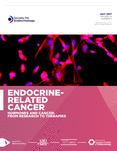15 YEARS OF PARAGANGLIOMA: Imaging and imaging-based treatment of pheochromocytoma and paraganglioma
- Department of Endocrinology, La Timone University Hospital, Aix‐Marseille University, Marseille, France
1Department of Biophysics and Nuclear Medicine, Medical University Innsbruck, Innsbruck, Austria
2Diagnostic Nuclear Medicine Division, Department of Nuclear Medicine, All India Institute of Medical Sciences, New Delhi, India
3Program in Reproductive and Adult Endocrinology, <ce:italic>Eunice Kennedy Shriver</ce:italic> National Institute of Child Health and Human Development, National Institutes of Health, Bethesda, Maryland, USA
4Department of Nuclear Medicine, European Center for Research in Medical Imaging (CERIMED), La Timone University Hospital, Aix‐Marseille University, 264, rue Saint‐Pierre, 13385 Marseille, France
5Institut Paoli‐Calmettes, Inserm UMR1068 Marseille Cancerology Research Center, Marseille, France
- (Correspondence should be addressed to D Taieb; Email: david.taieb{at}ap-hm.fr)
Abstract
Although anatomic imaging to assess the precise localization of pheochromocytomas/paragangliomas (PHEOs/PGLs) is unavoidable before any surgical intervention on these tumors, functional imaging is becoming an inseparable portion of the imaging algorithm for these tumors. This review article presents applications of the most up-to-date functional imaging modalities and image-based treatment to PHEOs/PGLs patients. Functional imaging techniques provide whole-body localization (number of tumors present along with metastatic deposits) together with genetic-specific imaging approaches to PHEOs/PGLs, thus enabling highly specific and sensitive PHEO/PGL detection and delineation that now greatly impact the management of patients. Radionuclide imaging techniques also play a crucial role in the prediction of possible radioactive treatment options for PHEO/PGL. In contrast to previous imaging algorithms used for either assessement of these patients or their follow-up, endocrinologists, surgeons, oncologists, pediatricians, and other specialists require functional imaging before any therapeutic plan is outlined to the patient, and follow-up, especially in patients with metastatic disease, is based on the periodic use of functional imaging, often reducing or substituting for anatomical imaging. In similar specific indications, this will be further powered by using PET/MR in the assessment of these tumors. In the near future, it is expected that PHEO/PGL patients will benefit even more from an assessement of the functional characteristics of these tumors and new imaging-based treatment options. Finally, due to the use of new targeting moieties, gene-targeted radiotherapeutics and nanobodies-based theranostic approaches are expected to become a reality in the near future.
- Revision received 1 June 2015
- Accepted 4 June 2015
- Made available online as an Accepted Preprint 4 June 2015
- © 2015 Society for Endocrinology












